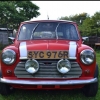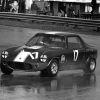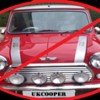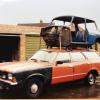
1275 Engine Rebuild
#1

Posted 12 October 2018 - 02:05 PM
#2

Posted 12 October 2018 - 02:29 PM
David Vizard's "Modifying the A Series" is the definitive guide.
You need to decide what you actually want from your engine. You don't need to do anything too exotic or expensive to get a nice tractable road engine.
#3

Posted 12 October 2018 - 02:47 PM
And thank you for the recommendation (I'm a bit clueless where might I find this?)
#4

Posted 12 October 2018 - 03:13 PM
#5

Posted 12 October 2018 - 03:22 PM
As a basis, a standard bottom end that is balanced, a good road cam, lighter flywheel, HIF44 carb, centre oil pick up and a ported head and you will have a nice engine.
As has been said before on TMF, it is all about the quality of the work that makes a good motor.
#6

Posted 12 October 2018 - 03:41 PM
#7

Posted 12 October 2018 - 04:58 PM
if ya boar it 1293 or 1310 cam 266 or 276 for rad and every use 286 for sumday driving haynes for all ya torque setting read both books befor you strip an engin or these a long dvd om minispare http://www.minispare...|Back to search
#8

Posted 12 October 2018 - 05:30 PM
I haven't come across the centre pickup, wondered if you could elaborate. Thanks :)
refers to the oil pickup pipe in the sump - standard configuration has the oil pickup at the right hand drain plug end of the gearbox which can result in oil starvation under hard left hand cornering. centre pickup, as named moves it more centrally to alleviate the issue.
not an expensive modification, and pretty straightforward.
Edited by KTS, 12 October 2018 - 05:34 PM.
#9

Posted 12 October 2018 - 05:38 PM
The key to improved engine performance is an improved gas-flowed head. Then a better cam, improved induction and exhaust systems and very accurate calculations and assembled are required.
#10

Posted 12 October 2018 - 06:04 PM
#11

Posted 12 October 2018 - 06:58 PM
A proper gas-flowed head like the great ones done by 'TurboPhil' on here is what you need as a start. The compression ratio must be calculated after accurate measuring of the machined block and pistons and following a 'trial build'.
You will need to write a full specification before starting the build. Measure everything very accurately before starting and then again after the machining has been done. Final machining is often necessary to get it absolutely right.
#12

Posted 12 October 2018 - 08:18 PM
#13

Posted 12 October 2018 - 09:30 PM
I always think the best thing is first of all to strip the engine and see what you have actually got by inspecting and measuring
Then write the detailed specification and list the parts needed.
There then needs to be a list of required machining work. The machine shop will need the pistons when they do the boring.
After the machining is done make sure you check the dimensions. machine shops have been known to make errors.
Always re-bore to the next size up for the pistons and the next size down for the main and big-end bearings.
Do a trial-build (sometimes called a 'dummy build'), in order to establish the amount needed to be skimmed from the block deck and to check the bearing fits, etc., and to establish what size the finished combustion chambers in the head need to be to give the compression ratio (CR) you have decided upon - probably about 10:1.
Then strip down for final machining and the final, very careful, assembly.
The key word during the final assembly is 'Cleanliness'.
PM me if you need more help.
#14

Posted 13 October 2018 - 01:16 AM
David Vizard's "Modifying the A Series" is the definitive guide.
David's books are great and probably more helpful than most, there's a lot of good info in them and the way he explains a lot of various aspects in his books is excellent, in that he doesn't just say, for example, use X head and Y Camshaft, but sets out good explanations of performance engineering and theory, but, and in particular these days, they are getting dated, though are a sound starting point.
However, I've always felt there is a HUGE gap between the Workshop Manuals and David's books in terms of basic workshop practices and machine shop operations. In the latter, I know very few of us would be doing own own engine machining, however, a good understand of want is involved and how 'things should be', I feel is essential, so you can talk the talk with the guys and not just get a 'sausage machine' type of job, but something that's better suited for performance. I see no point in spending loads of time & money in to an engine to get better performance, when all the bits are bought together in ways that looses performance.
In this regards, one series of books worth looking at is the HP range, though they'll generally be aimed at V8's, the workshop and machine shop principals are much the same. Another I can suggest is Des Hammil's books, he has 2 A Series Specific Books.
#15

Posted 13 October 2018 - 02:19 AM
I'm a little confused, are you rebuilding a 998 or building a 1275? You can't bore a 998 out to 1380 or anywhere near it.
I built a 1275 with high compression pistons (10.3:1) at 40 over, a 266 Kent cam, twins HS4's and a Keith Calver head with 14:1 rockers, it made 100 hp on the dyno, 80hp at the wheels and is very tractable and easy to drive in town, so it's definitely doable.
Dyno file for proof, this was before we finished the tune, we had to fine tune the needles a bit to get rid of the lean and rich spots.
Edited by Magneto, 13 October 2018 - 02:26 AM.
1 user(s) are reading this topic
0 members, 1 guests, 0 anonymous users



















